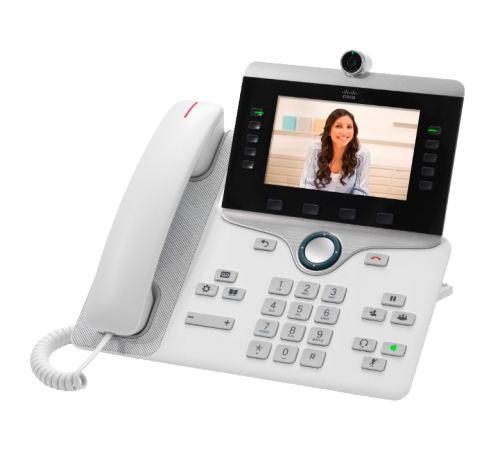Features | Specifications |
Audio codec support | - G.711 a-law and mu-law, G.722, G.729a, Internet Low Bitrate Codec (iLBC), and Internet Speech Audio Codec (iSAC)
|
Key call features support | - Dialing, Abbreviated dialing, Adjustable ring tones and volume levels, Adjustable display brightness, Agent greeting, Application launch pad, Auto-answer, Auto-detection of headset, cBarge, Busy Lamp Field (BLF), BLF Pickup, BLF speed dial, Callback, Call forward, Call forward notification, Call filter, Call history lists, Call park, Call pickup, Call timer, Call waiting, Call chaperone, Caller ID, Corporate directory, Conference, including traditional Join feature, Cross Cluster Extension Mobility (EMCC), Direct transfer, Extension mobility, Fast-dial service, Forced access codes and client matter codes, Group call pickup, Hold, Intercom, Immediate divert, Malicious-caller ID, Message-Waiting Indicator (MWI), Meet-me conference, Mobility, Music on Hold (MoH), Mute, Network profiles (automatic), On- and off-network distinctive ringing, Personal directory, PickUp, Predialing before sending, Privacy, Private Line Automated Ringdown (PLAR), Redial, Ring tone per line appearance, Service URL, Shared line, Silent monitoring and recording, Speed dial, Time and date display, Transfer, Uniform Resource Identifier (URI) dialing, Visual Voicemail, Voicemail, Whisper coaching.
|
Mobility and remote access | - You can deploy the phones remotely with the following two options:
- You can have your phone remotely registered to the on-premises network through a built-in VPN client if the administrator has provisioned this VPN feature
- You also can directly connect to the on-premises network without VPN through Cisco Expressway if you are provided with log-in credentials. Contact your system administrator
|
Electronic hookswitch | - You can control the hookswitch electronically with a third-party headset connected to either the USB or auxiliary port, or directly paired with the phone through Bluetooth
|
Cisco Intelligent Proximity | - Audio path moving sends audio through the phone for a mobile device-connected call
- Call-history synchronization allows you to view placed and missed calls of your mobile device from the 8865
- Contact synchronization allows you to synchronize the contact objects from your mobile device to your 8865
|
Quality-of-Service (QoS) options | - The phone supports Cisco Discovery Protocol and 802.1Q/p standards, and you can configure it with an 801.1Q VLAN header containing the VLAN ID overrides configured by the Admin VLAN ID
|
Network features | - Session Initiation Protocol (SIP) for signaling, Session Description Protocol (SDP), IPv4 and IPv6, User Datagram Protocol (UDP) (used only for Real-Time Transport Protocol [RTP] streams), Dynamic Host Configuration Protocol (DHCP) client or static configuration, Gratuitous Address Resolution Protocol (GARP), Domain Name System (DNS), Trivial File Transfer Protocol (TFTP), Secure HTTP (HTTPS), VLAN, Real-Time Transport Protocol (RTP), Real-Time Control Protocol (RTCP), Cisco Peer-to-Peer Distribution Protocol (PPDP), Cisco Discovery Protocol, LLDP (including LLDP Media Endpoint Discovery [LLDP-MED]), Switch speed auto-negotiation.
|
Security features | - Secure boot, Secure credential storage, Device authentication, Configuration file authentication and encryption, Image authentication, Random bit generation, Hardware cryptographic acceleration, Certificate Authority Proxy Function (CAPF), Manufacturer-Installed Certificates (MIC), Locally Significant Certificates (LSC), Ethernet 802.1x supplicant options: Extensible Authentication Protocol-Flexible Authentication via Secure Tunneling (EAP-FAST) and Extensible Authentication Protocol-Transport Layer Security (EAP-TLS), Signaling authentication and encryption using TLS, Media authentication and encryption using SRTP, HTTPS for client and server, Secure Shell (SSH) Protocol server, Secure Sockets Layer (SSL)-based VPN client.
|
Physical dimensions (H × W × D) | - 9.01 x 10.13 x 3.87 in. (228.78 x 257.34 x 98.39 mm) (excluding foot stand)
|
Weight | |
Phone-casing composition | - Polycarbonate Acrylonitrile Butadiene Styrene (ABS) textured plastic; Cosmetic class A
|
Operating temperature | |
Nonoperating temperature shock | - 14 to 140°F (-10 to 60°C)
|
Humidity | - Operating 10 to 90%, noncondensing
- Nonoperating 10 to 95%, noncondensing
|
Language support | - Arabic (Arabic Area), Bulgarian (Bulgaria), Catalan (Spain), Chinese (China), Chinese (Hong Kong), Chinese (Taiwan), Croatian (Croatia), Czech (Czech Republic), Danish (Denmark), Dutch (Netherlands), English (United Kingdom), Estonian (Estonia), French (Canada), French (France), Finnish (Finland), German (Germany), Greek (Greece), Hebrew (Israel), Hungarian (Hungary), Italian (Italy), Japanese (Japan), Latvian (Latvia), Lithuanian (Lithuania), Korean (Korea Republic), Norwegian (Norway), Polish (Poland), Portuguese (Portugal), Portuguese (Brazil), Romanian (Romania), Russian (Russian Federation), Spanish (Colombia), Spanish (Spain), Slovak (Slovakia), Swedish (Sweden), Serbian (Republic of Serbia), Serbian (Republic of Montenegro), Slovenian (Slovenia), Thai (Thailand), Turkish (Turkey).
|




